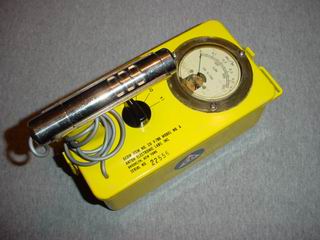Ionizing radiation is measured by a device called a Geiger counter. The Geiger counter is named after its inventor Hans Geiger who created the Geiger counter in 1908. Walther Müller collaborated on improving the counter in 1928 and the counters are also called Geiger-Müeller counters. A Geiger counter consists of a Geiger-Müeller tube which detects radiation by emitting a pulse of electrical energy when penetrated by ionizing radiation and supporting hardware.
Geiger-Mueller tubes come in a range of sizes, shapes and sensitivities. One end is open to allow the entry of ionizing radiation. Some Geiger counters allow thin shields which block alpha particles and thick shields which block beta particles to be shifted into position over the open end of the tube. The tube may be included inside a handheld device or it may be on a cable attached to a box containing the support hardware. Inexpensive Geiger counters for wide spread use have evolved over the years.
The US federal civil defense agencies had a Geiger counter design called a CD V-700 manufactured by 15 different contractors beginning around 1950.. The early models used special high voltage batteries which were replaced by standard D cells in the later models. CD V-700 design included bulky metal box about twelve inches long by eight inches high by six inches wide and weighting about 5 pounds. The box has a long handle running the length of the top. The Geiger-Müeller tube is about nine inches long and three inches in diameter on a thirty six inch cable. The CD V-700 is used to detect gamma and beta radiation. Some were modified to be able to detect alpha radiation by making the window in the end of the tube larger to provide more area. Tens of thousands of these models were distributed to build state and local civil defense agencies in the 1950s and 1960s These Geiger counters are what people usual think of when Geiger counters are mentioned. They have been featured in many movies and television shows and many are still in use today.
A newer design was manufactured for the U.S. government in the 1980s by the Victoreen company, one of the contractors for the original CD V-700. The model 496 was build in the same box as the CD V-700 but featured some improvements such as BNC connectors for external probes, a built in speaker that clicks to indicate radiation, a batter test circuit and a meter graduated in clicks per minute.
A new generation of handheld Geiger counters has evolved since the CD V-700 and 496. These new models are very light and portable. The Geiger-Müeller tubes are inside the cases which are about six inches by three inches by one inch. The whole units weight around six ounces. These new designs feature digital displays, moveable shields for blocking alpha and beta radiation, internal memories, switchable units for measuring radiation, audio output, interfaces for connecting to computer and software for manipulating data on radiation measurements.
Further advancements in radiation measurements include Geiger-Müeller tubes with USB connectors to directly connect to computers and cell phones with radiation detectors built in. There has been an explosion of design, manufacture and sales recently driving by fears of wide spread radiation contamination related to the Fukushima disaster.
